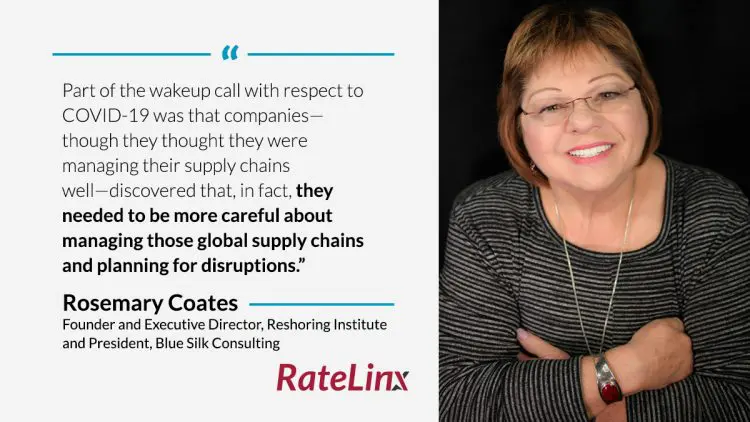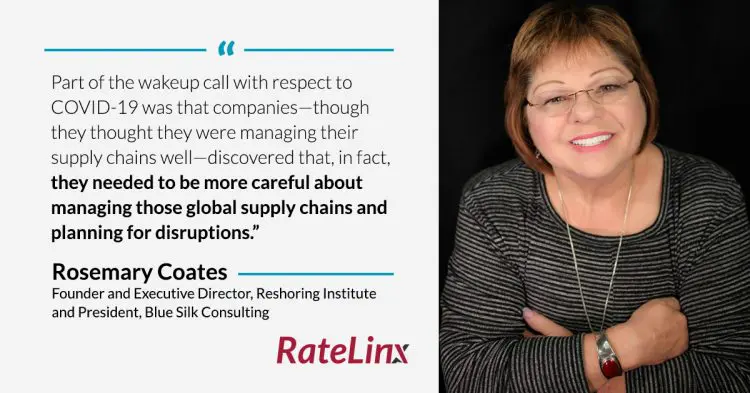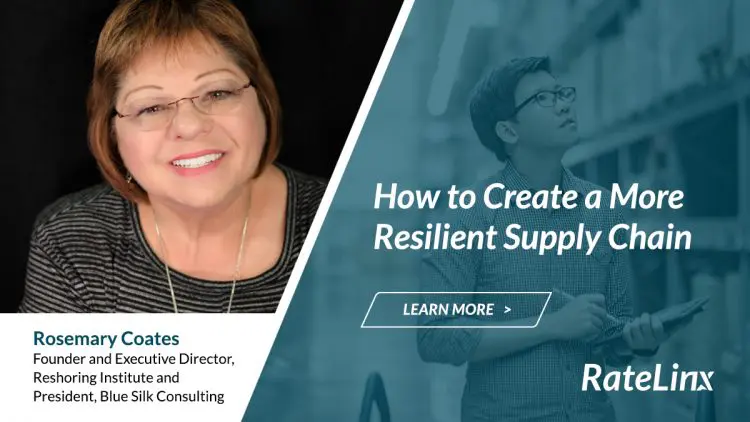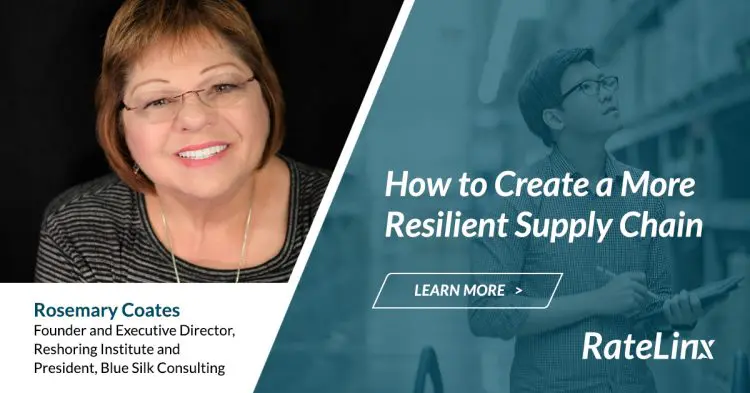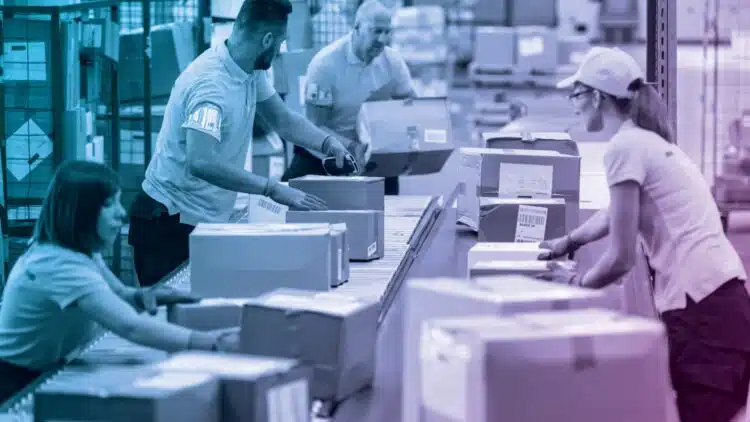If there’s one word those in supply chain management hate to hear, it’s “uncertainty.” Success in supply chain comes from its antonym: certainty. From the point of origin to the final destination, everyone across the chain of custody needs to play their part to create predictability. It’s a tough promise to fulfill without a little flexibility.
What happens if, say, a global pandemic strangles suppliers and creates unpredictable disturbances across the supply chain? The entire thing falls apart without the ability to pivot. It’s a reality many supply chain managers faced in early 2020. Otherwise, healthy supply chains shut down. We are still feeling the effects today.
“Here we are seven months into this pandemic, and we still can’t get simple Clorox wipes! To me, that is a massive failure for supply chain,” says Rosemary Coates, Founder and Executive Director of the Reshoring Institute and President of Blue Silk Consulting.
Rosemary’s tone is half frustration, half-humorous. She uses the most straightforward example to illustrate exactly what many supply chain managers are asking themselves behind closed doors right now. How can we create more resilient supply chains?
Featured Expert

Rosemary Coates
Rosemary is a Global Supply Chain, Procurement, and Manufacturing Expert focusing on Chinese sourcing and manufacturing, and logistics with 30 years of experience in industry, consulting and expert witnessing. An author of 5 supply chain books, including an Amazon.com best seller, she has consulted with 80 countries around the world and across a diversity of industries.
Recommended Reading:
Rosemary is a supply chain veteran of 30 years, a Chinese Manufacturing Expert Witness, and a Global Supply Chain Management Consultant with an MBA and experience in Management Consulting. She knows a thing or two about global supply chains and what it takes to strengthen them.
We sat down with Rosemary to understand more about what it takes to create resilience and certainty in supply chain, despite ever-looming uncertainties.
COVID-19 is a Wakeup Call for Supply Chain
It’s easy to point the finger at COVID-19 and feign helplessness regarding the global pandemic’s effect on supply chains. Rosemary argues that supply chain management needs to see the pandemic for what it is: a wake-up call.
“Part of the wake-up call with respect to COVID-19 was that companies—though they thought they were managing their supply chains well—discovered that, in fact, they needed to be more careful about managing those global supply chains and planning for disruptions.”
She details how the situation unfolded for many in supply chain management, and how the problem got so out of control so quickly. The virus shut down Wuhan and all the factories in the area—known for automotive manufacturing and heavy metals; major industries. Immediately, companies buying or sourcing products from Wuhan got “the short shift,” according to Rosemary.
“That was kind of the first wakeup call that came, which, for American companies, in particular, meant recognizing the vulnerabilities in their supply chain and how fragile those supply chains actually are. Focusing on that and how you shore up risk is now a very important part of company strategy.”
“It’s not enough to say you want a more resilient supply chain. You need a Plan A and a Plan B and a Plan C, depending on what happens next”
Rosemary paints the pandemic not as a failure so much as a lesson. Companies recognizing the vulnerabilities in their supply chain will come out of COVID-19 stronger. Those who still haven’t managed to right the ship and meet demand need to knuckle down.
Make Sure Your Backup’s Backup Has a Backup
Faced with massive supply chain disruption and uncertainty, what are supply chain managers to do? The clear solution rests in contingency planning. Rosemary argues that contingency planning creates layers of certainty and it invites optimality and flexibility into supply chains.
Like what you’re reading?
“It’s not enough to say you want a more resilient supply chain. You need a Plan A and a Plan B and a Plan C, depending on what happens next,” says Rosemary. “It’s very likely that we’re going to have other disruptions—whether it’s a hurricane, or a typhoon, or floods in central China, or, you know, a pandemic. Any number of things! One plan is not enough, because terrible things happen in all shapes and sizes.”
Rosemary has been doling out the same advice for decades. She has consulted with 80+ global and domestic clients on systems and processes—many of them are focused on creating certainty across the supply chain, from procurement to fulfillment. Her philosophy isn’t so much about predicting, but preparing.
“Most of us knew that supply chains were very dependent on certain parts of the world—China in particular—for a long time. It’s not really that much of a surprise. What is kind of a surprise is that we didn’t have alternatives established and ready to go.”
Flexibility Strengthens Supply Chains
“I work with my clients and tell them they absolutely need a Plan A and a Plan B and a Plan C that are all different. Maybe you’re tapping into different parts of the world so you can move your supply chain around? Whether it’s manufacturing or sourcing, I think that [flexibility] strengthens supply chains overall because it gives you a number of options.”
Rosemary argues that supply chain’s current challenges aren’t mysterious unknowns or big question marks—instead, they’re exactly what they’ve always been. Only now, COVID-19 has shed a blinding light on them.
“Most of us knew that supply chains were very dependent on certain parts of the world—China in particular—for a long time. It’s not really that much of a surprise. What is kind of a surprise is that we didn’t have alternatives established and ready to go.”
Supply Chains Need Context, Perspective
Who’s going to make the decision to diversify their supply chain? What’s the precedent for establishing backchannels and alternative fulfillment solutions? It’s easy to get bogged down by questions, which is why Rosemary urges companies to identify their strategists—the people focused on the bigger picture.
“Think of it from a procurement perspective. You’ve got buyers who get requisitions, and they have to buy certain parts and so forth. They’re busy buying. And busy with the process. They are not busy developing lots of alternatives and thinking ahead strategically to what might happen,” she says. “I think where we get a little bit off track is thinking that these are the supply chain people; they’re components of the supply chain. There has got to be an overall strategy on top of that.”
Long-term Strategies Needed in Supply Chain Management
Rosemary immediately hits on the core of the problem: lack of long-term vision. She argues that, while important, quarterly planning and profit-driven decision-making aren’t always the best tools for developing sustainable strategies.
“We are just not good at strategizing long-term in America. We plan quarter to quarter, looking at our Wall Street results and what kind of profits we’re making this quarter, and so forth. We’ve blocked off this idea of long-term planning and alternative planning, and I think that’s now starting to bubble up a little bit.”
Companies looking for a one-size-fits-all solution to contingency planning and flexibility also need to beware. While there are plenty of philosophies for sustainable planning out there, context means a lot in an industry as dynamic and unpredictable as supply chain.
“We have developed this affinity for Lean manufacturing, across companies—simplifying processes and attempting to reduce inventory in the pipeline, and so forth. There’s this urgency day after day to think about Lean,” says Rosemary. “I think the pandemic has really demonstrated that [Lean] is a strategy, but you need to have an alternate strategy as well. You can’t just depend on this thin pipeline when something goes wrong, because you’re in a world of hurt when that happens.”
Beyond Just Moving Boxes, Supply Chain Is Alive
The ability to adapt after COVID-19 has a lot to do with how companies see their supply chains. With the rise of technology and data has come the rise of supply chain proficiency. But not every company sees supply chain for what it is: the gears that keep a company turning.
“I’ve been in global supply chain management for 30 years. When I started, supply chain was all about moving boxes around the world, making sure that you got shipments on time. Along the way, supply chain has really been elevated in a company structure. Now, supply chain professionals have a seat at the executive table. A lot of C-level executives have been hired and are included in the strategic thought of the company,” says Rosemary.
“The leadership role—by and large, and certainly at an executive level—is a strategic thinking role. It’s heavily weighted on the strategy side. The day-to-day operation sets are obviously on the execution side.”
A growing emphasis on the nuts and bolts of supply chain and its optimization opportunities is one thing. Bringing on staff with the background and capabilities to explore them is another. Often, there’s a gap. It’s something Rosemary has helped companies recognize and remedy for years. She sees several solutions for closing that gap—from hiring multifaceted thinkers, to bringing more perspectives to the table.
Today’s Leaders Need Strategic and Execution Skills
“In today’s environment, you’ve got to think cross-functionally and understand the direction of the business,” she says. “When I graduated undergrad with a degree in logistics, it was all about execution and was very operationally-oriented. There was pretty much no strategy piece to it. Today, you need both strategic and execution skills—and those are different things. There are very few people that can do both or cross over back and forth. Upskilling, different kinds of leadership, different kinds of education, and more—these are things contributing to the development of supply chains.”
Rosemary goes on to talk about the benefits of cultivating a team equally weighted in strategy and execution, thinking vs. doing. In her opinion, it comes down to the relationship between leaders and those working under them, directly within supply chains.
“The leadership role—by and large, and certainly at an executive level—is a strategic thinking role. It’s heavily weighted on the strategy side. The day-to-day operation sets are obviously on the execution side.”
Integration of Operations Unlocks Resiliency
Contingency planning. Forward-looking strategies. Cross-disciplined teams. Where does all this take us? Individually, they’re the ingredients to certainty within supply chains. But, to bring them all together, Rosemary argues that we need to master one more important prospect: integration.
“For years we operated in isolation. Each department or division of a company was separate from the other and didn’t work very well together. But the implementation of the ERP [enterprise resource planning] systems in the late 80s and early 90s started the trend to change that,” says Rosemary. “Now, we understand that there’s cause and effect relationships across the whole organization. When I do something in purchasing, it affects the receiving department. When I do something in strategic planning, it affects execution, and so forth.”
Her emphasis on broader oversight for supply chains coincides with the mass movement to de-silo data many companies have begun to embrace. As data becomes available and develops context alongside other vital business units, the supply chain will grow stronger—more resilient. It’s up to leaders to take that information and use it to create proactive benefits for their supply chains.
“A leadership role that encourages cross-pollination is important when you’re asked and expected to work together with your colleagues across the organization. If done right, the supply chain becomes very integrated.”
A Bump in the Road to a More Resilient Future
There’s no denying the damage to supply chains caused by COVID-19. Rosemary isn’t the only person frustrated with the lack of stocked shelves or availability of products. The difference is, she can see past the current failure of supply chains to opportunities created by the pandemic. Her advice? Embrace the lesson and make plans to avoid future, similar setbacks.
You don’t have to anticipate the future to prepare for it; you need the ability to both strategize and execute proactively. Long-term planning necessitates preparedness, which demands flexibility, which culminates in resilience.
